Moissanite is often considered little more than a low cost diamond alternative, but we think it deserves a lot more than just a passing thought.
If you’ve been following us for a while, you’ll have seen we regularly showcase engagement rings featuring moissanite. Importantly, for most of those customers, moissanite was their first choice as the hero gemstone.
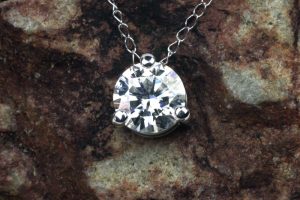
Dazzling D-F colour, round cut, 6mm moissanite pendant
Indeed, there are many lovers of moissanite out there. It’s a gem that brings some very sparkly wonderfulness to the jewellery world, but what is it exactly?
Technically, moissanite is silicon carbide (silicon + carbon), but that doesn’t explain a whole lot to most people.
When we think of silicon the mineral, we think sand and glass making or silicon chips in computers.
A ‘carbide’ is a class of compounds that are composed of carbon and (typically) a metal or semi-metallic element. A common example of a carbide is tungsten carbide – used often on industrial cutting tools because of its hardness and resistance to wear.
So, basically, moissanite is a compound made up of silicon and carbon and, from a jewellery perspective, it performs a lot like diamond.
Where does moissanite come from?
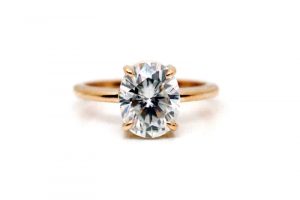
Moissanite comes in a variety of cuts, including oval cut – like the one in this eye-catching solitaire engagement ring.
Though it is also a naturally occurring mineral, almost all moissanite that appears in jewellery is human made.
First discovered adjacent to a meteor crater in Arizona by Henri Moissan in 1893, natural moissanite is rare. Other than beside the occasional crater, sometimes it shows up in volcanic rocks and as inclusions in diamonds. Typically, it’s translucent grey in colour.
Because of its rarity and generally unremarkable colouration, natural moissanite isn’t often used in the fine jewellery world, but its human-made equivalent is extremely popular.
Moissanite was first synthesised on a commercial scale in the late 1890s and for the next 100 or so years it was mostly used as an industrial abrasive or coating.
It wasn’t until Charles & Colvard patented their process for creating jewellery grade crystals in 1998 that moissanite started to gain commercial appeal in jewellery making.
Though their patents have now expired throughout most of the world, Charles & Colvard are still recognised as the premier manufacturer of jewellery-grade moissanite, and they are our preferred (and only) supplier.
What’s the difference between diamond and moissanite?
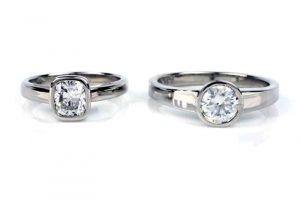
See for yourself. On the left is a 0.91 carat, GVS1, cushion cut, lab-created diamond. On the right is a 6.5mm D-F colour moissanite. If they weren’t side by side, would you pick the difference?
Moissanite is often thought of as a diamond alternative, but that is largely on the basis of how they look. Chemically there’s a big difference between the two. Diamond is essentially 99.99% pure carbon. Moissanite is, as we mentioned, a compound of silicon and carbon.
However, appearance-wise, the average person will likely have difficulty distinguishing moissanite from diamond. Sure, once you’ve been around both for a while and have become familiar with how they perform, you can tell them apart, but most people can’t.
Like diamonds, how well a moissanite gem performs optically depends greatly on the cut and the clarity of the parent crystal itself. But side by side, when you compare what you might roughly call ‘equivalent’ coloured, size and cut gems, moissanite will show up as being more sparkly or ‘blingy’. The molecular structure of moissanite sees it internally reflect ‘rainbows’ of light, and this is where the ‘bling’ comes from.
Hardness-wise, moissanite rates 9.5 on Mohs scale. Diamond rates 10. And while that mightn’t sound like much of a difference, Mohs scale is exponential which means diamonds are still significantly harder than moissanite.
Does that fact matter much from a jewellery perspective? No. Not really.
Both gems are tough, and both will chip or fracture if you whack them hard enough on the wrong surface. The thing is, breaking a diamond is a lot more expensive than breaking a moissanite.
Which brings us to the biggest difference from a jewellery buyer’s perspective. Cost.
How does the price of moissanite compare with diamond?
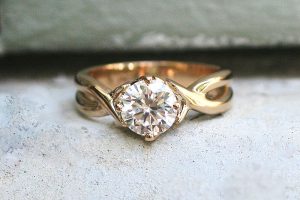
Moissanite is every bit as stunning when set in yellow gold as it is in platinum or white gold
Straight off the bat as a broad statement, moissanite is a lot less expensive than diamond.
Making a like-for-like comparison is a bit tricky though, for a few reasons.
To make a meaningful cost comparison, we need to use physical size rather than carat weight. Because diamond and moissanite have a different specific gravity, diamond weighing almost 10% heavier for the same volume.
Price is also a bit difficult to compare because diamonds can vary enormously in price depending on clarity, cut and colour, even if the weight from one gem to the next is the same.
In other words, any price comparison we give you is going to be a generalisation. Plus, these days lab-created diamonds are in the mix – which complicates things a little further. (You can learn more about lab-created diamonds here.)
Fortunately, Charles & Colvard grade their larger gems for colour, so at least we can make a comparison based on cut, colour, and physical size. We’ll also base our comparison on ‘eye-clean’ stones, that is, stones that don’t have any inclusions or impurities visible to the naked eye.
The most popular size for round cut moissanite is 6mm in diameter – which is similar to a 0.80 carat diamond.
As of November 2020, the going price for a 6mm Charles & Colvard Forever One ® moissanite is:
- $650 for a gem in the DEF colour range; or
- $500 for a gem in the GHI colour range.
For an “equivalent” lab-created diamond, 6mm in diameter (80 points), VS1+, your budget would need to be $1,800 – $2,700 depending on the colour and clarity. By comparison, a recycled mined diamond, would likely start at $7,800+ for an eye-clean G colour.
As you can see, moissanite costs a whole lot less “like for like”, but does that make it good value?
Is moissanite good value?
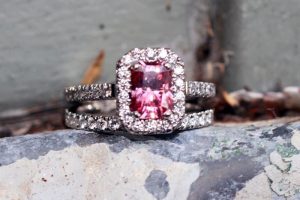
Pink is another option for moissanite. This 7x5mm emerald-cut beauty is surrounded by 18 x 1.3mm recycled diamonds with the shoulders of the ring featuring a further 14 recycled diamonds that are 1.5mm in diameter.
As we said earlier, there are many admirers of moissanite who don’t even think to compare them with diamonds. They simply love the gemstone for what it is and don’t consider what it isn’t.
If you’re a moissanite fan and simply want it for all its beautiful sparkly-ness, its affordability is a big bonus. So, you’d have to say ‘yes’, it is good value.
But if you’re looking at moissanite as an alternative to buying diamonds, you really need to consider your own perception of what represents value.
If you’re on a really tight budget, then moissanite is probably the best non-diamond alternative if you want something that actually looks like a diamond and will go the distance. (CZs might look similar to begin with, but they’re relatively soft and erode easily so they lose their sparkle quickly.)
Another way to look at this is to think about your financial circumstances right now.
If you’d really like a diamond but it makes more sense to you to put your money into a house deposit than a diamond, then moissanite is definitely an excellent stand in. After all there’s no reason why you couldn’t switch to diamond of your choice later on when you’re more cashed up.
At the end of the day, moissanite is a relatively low cost, quality diamond alternative.
But that said, it’s important to remember moissanite doesn’t exist just as a diamond alternative. It’s its own thing and a great many people wear them proudly.
The 1940s Broadway show; “Gentlemen Prefer Blondes”, might’ve convinced us all those years ago that diamonds are a girl’s best friend, but that was then, and this is now. There’s no reason why moissanite can’t be your best friend in the 2020s.
Ethical Jewellery Australia specialises in creating engagement and wedding rings that are as environmentally and socially responsible as we can make them. Every ring we produce is designed one-on-one with our customers and we would be delighted to help you design yours and make it for you.
Drop us a line at [email protected] if you’d like us to help you create a ring or rings you and your partner will love.
About EJA
Ethical Jewellery Australia is an online engagement, wedding ring and bespoke jewellery specialist. Every piece we do is custom designed and made to order (with the exception of simple wedding and commitment rings that are offered in a range of simple, popular designs).
We take our customers through the whole process from design to sourcing and finally to manufacturing.
All rings are handmade in Australia with recycled metals. (We can also supply Fair Trade gold if requested.)
Likewise, we only every use ethically sourced diamonds and gemstones. You can choose from Argyle, recycled, vintage and lab-grown diamonds, Australian, US, Fair Trade, recycled and lab-grown coloured gemstones.
By the way, we offer an Australia-wide service.
About the Author: Benn Harvey-Walker
 Benn is a Co-founder of Ethical Jewellery Australia and a keen student of ethical and sustainability issues in the jewellery world. He has a long history in sales and marketing and began working with EJA full time in early 2018.
Benn is a Co-founder of Ethical Jewellery Australia and a keen student of ethical and sustainability issues in the jewellery world. He has a long history in sales and marketing and began working with EJA full time in early 2018.
Benn co-authored the original Engagement Ring Design Guide in 2014 and edited the 2nd Edition in 2018. He is also the principal author of our Wedding and Commitment Ring Design Guide.
His main responsibilities at EJA are business development and sales process management. Benn also creates technical drawings for our ring designs.

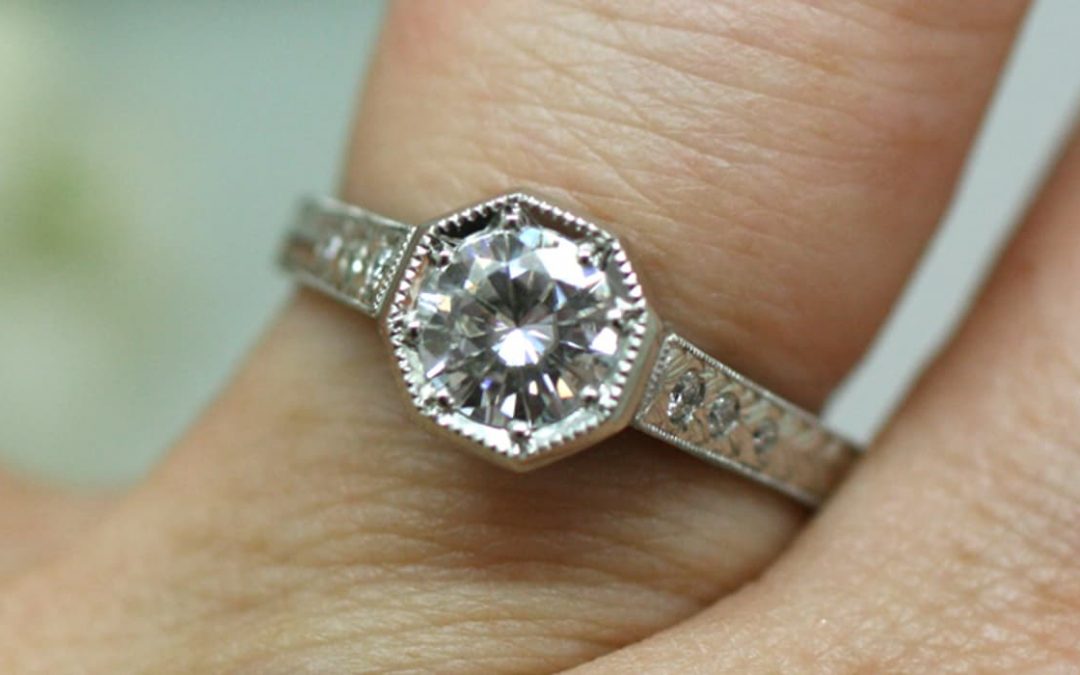
Recent Comments